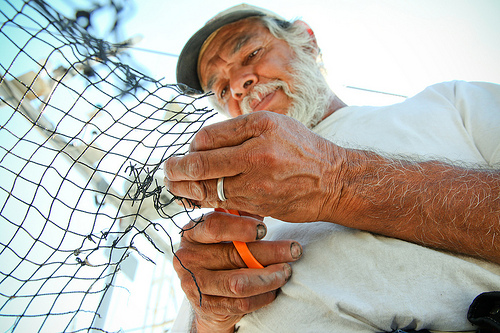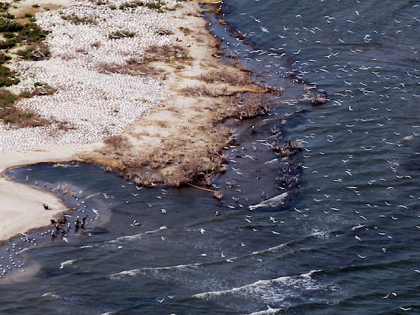http://www.huffingtonpost.com/rocky-kistner/holidays-on-the-oil-spill_b_4336850.html
video at:
http://www.huffingtonpost.com/rocky-kistner/holidays-on-the-oil-spill_b_4336850.html?utm_hp_ref=green
Huffington Post
Rocky Kistner
Media associate, NRDC
Posted: 11/25/2013 12:10 pm
This will be J.J. Creppel’s last Thanksgiving at his home in Plaquemines Parish, a sliver of marshy land that juts out from the southeast corner of Louisiana and hugs the Mississippi River as it empties into the Gulf of Mexico. But J.J. says after 60 years, he’s finally leaving the Cajun fishing community he loves so dearly. For many like him, life has changed since the BP oil disaster errupted more than three years ago. “The oil spill finished off the shrimp,” he says in a whisper.
Although domestic shrimp prices are up this year, giving a much-needed boost to fishermen down on their luck since the blowout, catches remain depressed in the areas like the Barataria Bay region, a productive fishing ground hard hit by BP oil. Lower catches combined with damages from storms and rising seas makes it harder to make a living fishing in the bayou these days. “I used to make nets for the people,” J.J. says. “But not too many people are buying nets anymore.”
While BP continues to spend millions on slick TV commercials touting the good times in the Gulf, communities in Plaquemines are still feeling the effects of the country’s worst oil spill in history. This year, cleanup crews collected more than 3 million pounds of oily material and tar balls from Louisiana coasts and marshlands, three times what it collected last year. Fishermen worry that in places like Barataria Bay, where fishing is still off limits in some areas due to oil contamination, the impacts will continue to ripple through the ecosystem. They are especially worried about future generations of shrimp, crab and oysters that could be hurt by the massive oil and chemical dispersant mix that poured into the Gulf after BP’s Deepwater Horizon rig exploded three years ago.
“We’re only three years out since the spill and everybody knows the oil is still out there,” says Clint Guidry of the Louisiana Shrimp Association, which represents shrimpers across the state. “The issue is what’s happening in the most affected areas. If you look at a map where most of the oil went, we’re still having problems.”
Fishermen also continue to report that some shrimp have what appears to be oil contaminated cavities and tumors they link to the oil spill. Barataria Bay shrimper Randy Varney says his shrimp catch has declined 50% in some areas this year. He says he occasionally finds shrimp with tumors and a black oil-like substance that he’s never seen before the spill.
But that’s not all that bothers him. Since he spends much of the hot summer of 2010 working on oil cleanup boats during the BP blowout, Randy says he continued to have health problems he never had experienced before, including chronic respiratory problems, rashes, dizziness, memory loss and sore eyes that plague him to this day. Randy says he was not allowed to wear a respiratory while he was handling toxic oily boom during the cleanup, and he blames the chemical cocktail of Corexit dispersant and BP crude for his ongoing health problems. “I don’t know what it is, but I never feel good, it’s like I constantly have a cold, my eyes bother me and I always have a sore throatŠ.doctors don’t what it is but I feel like I’ve been poisoned.”
Shrimp with tumors and a black substance caught in Barataria Bay in October.
That’s an ongoing refrain of some fishermen who found themselves at ground zero of the BP disaster, health problems that were chronicled in this detailed investigation released this year by the Government Accountability Project. Most of the media has moved on and ignored the plight of the fishing community in the Gulf. But reporters like Dahr Jamail of Al Jazeera continue to track problems in the fisheries and among residents in the Gulf. Here’s what he reported last month:
“It’s disturbing what we’re seeing,” Louisiana Oyster Task Force member Brad Robin told Al Jazeera. “We don’t have any more baby crabs, which is a bad sign. We’re seeing things we’ve never seen before.” Robin, a commercial oyster fisherman who is also a member of the Louisiana Government Advisory Board, said that of the sea ground where he has harvested oysters in the past, only 30 percent of it is productive now. “We’re seeing crabs with holes in their shells, other seafood deformities. The state of Louisiana oyster season opened on October 15, and we can’t find any production out there yet. There is no life out there.”
Oiled beaches of Grand Isle, LA, October 2013. Photo: Gulf Restoration Network.
It will be years before the massive amount of science now underway in the Gulf becomes public, but already there is evidence that the oil disaster will have a lasting impact on the ocean environment for decades to come. Many fishermen still don’t know what the future holds for their livelihoods, a threat that looms over their holiday season for the third year in a row.
But communities in the Gulf aren’t the only residents battling oil spills that have changed their communities and their lives this Thanksgiving. In Mayflower, AR, many residents have complained of health problems they link to a massive tar sands leak from a ruptured ExxonMobil pipeline last March. The blowout spewed over 200,000 gallons of sticky black Canadian tar sands crude through the small town into a marsh in nearby Lake Conway, one of the prized fishing locations in the state.
After Exxon ripped up much of the vegetation in the area this summer, much of the oil still remains embedded in the marsh. Residents say every time it rains, tar sands residue washes toward the culvert that drains into the main body of Lake Conway.
Oil in cove of Lake Conway in October. Photo: Genieve Long
Genieve Long, who lives near the oil-soaked cove, has suffered repeated health problems she blames on the oil (check out this recent documentary on the Mayflower oil spill from Inside Climate News). She continues to worry about the health of her family of four kids. Exxon and state authorities insist they are not in danger while the environmental testing continues. But that is little consolation to people like the Long family, and Genieve says she’s not sure where her family will celebrate their Thanksgiving meal.
“I don’t really want to invite people to my house and expose them, knowing what’s really going on here,” Genieve says. “We’re not the only family around here this spill has taken a huge toll on. It’s just heart-breaking to seeŠ. I wouldn’t in my wildest dreams have thought this is the way things would be around the holidays.”
For those who want to help families suffering this holiday season from toxic oil spills in their backyards, join the Front Line Holiday campaign on Facebook, organized by Gulf coast community and environmental advocate Cherri Foytlin. The campaign plans to deliver gifts and assistance to needy children and families across the country where their air, water and environment has been hit hard by impacts of the fossil fuel industry and other climate-related disasters.
Watch this video of J.J. produced by NRDC in 2010 in collaboration with StoryCorps and BridgetheGulf as part of its Stories from the Gulf project.

J. J. Creppel repairing shrimp nets. Photo: Lisa Whiteman/NRDC
Follow Rocky Kistner on Twitter: www.twitter.com/rockyatnrd
Special thanks to Richard Charter
